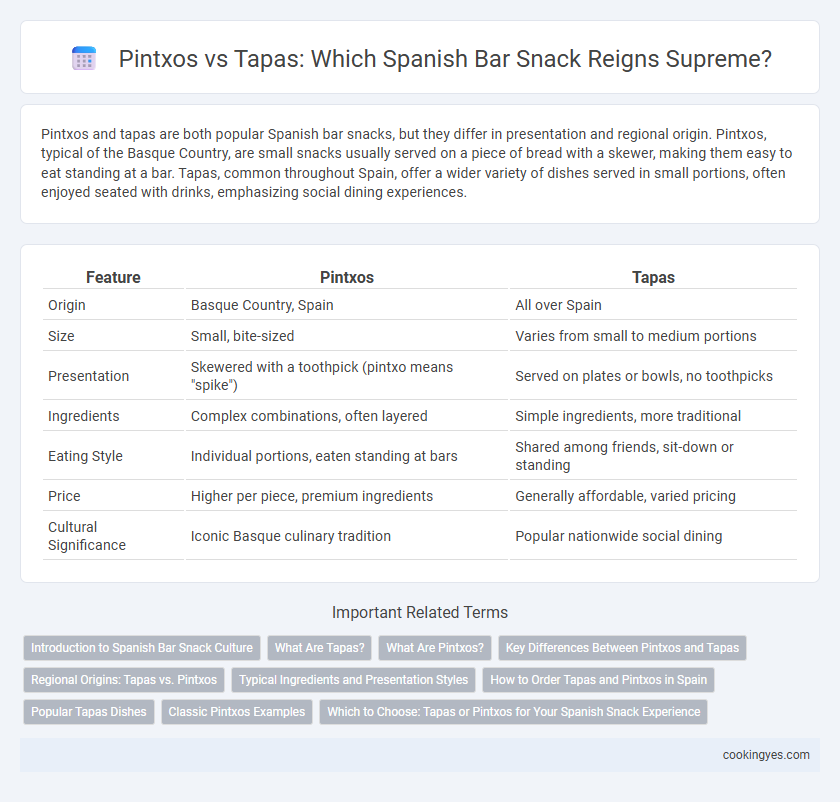Pintxos and tapas are both popular Spanish bar snacks, but they differ in presentation and regional origin. Pintxos, typical of the Basque Country, are small snacks usually served on a piece of bread with a skewer, making them easy to eat standing at a bar. Tapas, common throughout Spain, offer a wider variety of dishes served in small portions, often enjoyed seated with drinks, emphasizing social dining experiences.
Table of Comparison
| Feature | Pintxos | Tapas |
|---|---|---|
| Origin | Basque Country, Spain | All over Spain |
| Size | Small, bite-sized | Varies from small to medium portions |
| Presentation | Skewered with a toothpick (pintxo means "spike") | Served on plates or bowls, no toothpicks |
| Ingredients | Complex combinations, often layered | Simple ingredients, more traditional |
| Eating Style | Individual portions, eaten standing at bars | Shared among friends, sit-down or standing |
| Price | Higher per piece, premium ingredients | Generally affordable, varied pricing |
| Cultural Significance | Iconic Basque culinary tradition | Popular nationwide social dining |
Introduction to Spanish Bar Snack Culture
Pintxos and tapas are iconic Spanish bar snacks that highlight regional variations in Spain's culinary culture. Tapas, traditionally associated with Andalusia, consist of diverse small plates that encourage communal dining and socializing. Pintxos, originating from the Basque Country, are typically skewered snacks served atop bread, emphasizing both presentation and ingredient quality in pintxo bars.
What Are Tapas?
Tapas are traditional Spanish bar snacks consisting of small portions of savory dishes designed for sharing and complementing drinks. Unlike pintxos, which are typically skewered with toothpicks and often served individually, tapas encompass a wider variety of preparations such as olives, cheeses, and fried seafood served on small plates. Originating from Andalusia, tapas embody Spain's social dining culture, encouraging communal eating and tasting multiple flavors in one sitting.
What Are Pintxos?
Pintxos are traditional Basque bar snacks typically consisting of small pieces of bread topped with various ingredients such as seafood, meats, and vegetables, often secured with a skewer. Unlike tapas, which can be shared plates, pintxos are individually portioned and designed for quick, flavorful bites. These snacks highlight regional specialties and emphasize presentation, making them a unique cultural experience in northern Spain.
Key Differences Between Pintxos and Tapas
Pintxos and tapas are both popular Spanish bar snacks, but pintxos are typically smaller, individually skewered bites served on bread with a toothpick, primarily found in the Basque Country. Tapas are a wider variety of appetizers or small dishes that can be served hot or cold and are more common throughout Spain. The key difference lies in presentation and regional origin, with pintxos emphasizing convenience for standing bar dining and tapas focusing on a shared, social eating experience.
Regional Origins: Tapas vs. Pintxos
Tapas originate from Andalusia in southern Spain, characterized by small, varied dishes served alongside drinks to encourage socializing and sharing. Pintxos hail from the Basque Country in northern Spain, distinguished by bite-sized snacks typically skewered with a toothpick to keep ingredients intact. Regional culinary traditions influence both, with Andalusian tapas favoring a mix of hot and cold plates, while Basque pintxos emphasize artistry and local seafood.
Typical Ingredients and Presentation Styles
Pintxos, originating from the Basque Country, typically feature skewered ingredients like marinated olives, anchovies, and cured meats, elegantly arranged on small slices of bread, often held together with a toothpick. Tapas, more widespread throughout Spain, encompass a broader variety of bite-sized dishes such as patatas bravas, chorizo, and tortilla espanola, served on small plates without skewers. The presentation style of pintxos emphasizes individual, handheld portions designed for quick consumption, while tapas are often shared among groups with plates passed around the table.
How to Order Tapas and Pintxos in Spain
Ordering pintxos in Spain typically involves selecting small snacks from a bar counter, often spearheaded with a toothpick, which serves as a tally for your bill. Tapas, on the other hand, are usually ordered from a menu or counter, with portions varying significantly and often meant for sharing among diners. Both pintxos and tapas emphasize social dining, but pintxos focus on individual servings enjoyed standing at the bar, while tapas encourage a seated, communal experience.
Popular Tapas Dishes
Popular tapas dishes like patatas bravas, jamon iberico, and gambas al ajillo highlight the variety found in Spanish bar snacks, contrasting with pintxos that often feature small skewered bites topped with ingredients like anchovies or chorizo. Tapas emphasize shared plates with diverse flavors and textures served across Spain, while pintxos originate from the Basque Country with a focus on individual, artfully crafted portions. Both offer a rich culinary experience, but tapas showcase a broader regional assortment of traditional Spanish flavors enjoyed in larger groups.
Classic Pintxos Examples
Classic pintxos, originating from the Basque region, are small skewered snacks typically served on a slice of bread and often include ingredients like anchovies, peppers, and olives. Unlike tapas, which vary widely in size and presentation, pintxos are usually bite-sized and structured with toothpicks to hold components together. Popular examples include Gilda (anchovy, olive, and pepper skewer), tortilla de patatas pintxos, and chistorra-stuffed baguette bites, highlighting the unique cultural specificity of pintxos in Spanish bar snacks.
Which to Choose: Tapas or Pintxos for Your Spanish Snack Experience
Tapas and pintxos both offer authentic Spanish bar snack experiences, with tapas featuring a wide variety of small plates commonly enjoyed throughout Spain, while pintxos are distinctive to the Basque Country, typically served as bite-sized snacks skewered with toothpicks. The choice depends on preference for interaction and variety: tapas encourage sharing multiple dishes at the table, whereas pintxos promote a grab-and-go style at the bar, allowing for sampling diverse flavors quickly. For an immersive social experience, opt for tapas, but if you prefer tasting numerous small bites with ease, pintxos provide a vibrant snack option.
Pintxos vs Tapas for Spanish bar snacks Infographic

 cookingyes.com
cookingyes.com